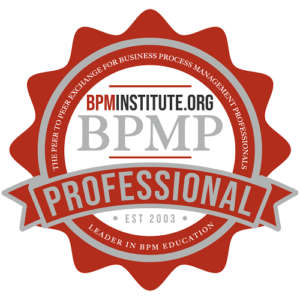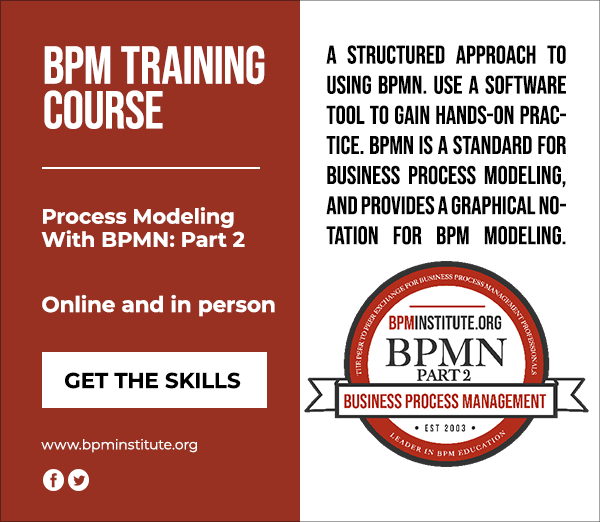Process Modeling With BPMN: Part 2 – Face-to-Face
$1,195.00
The objective of BPMN is to support business process management for both technical users and business users by providing a notation that is intuitive to business users yet able to represent complex process semantics.
| Course Date | Standard Rate | Buy Before | Your Rate | Savings |
|---|---|---|---|---|
| Apr 17 '25 | $1,195.00 | — | $1,195.00 | $0.00 |
| Jun 12 '25 | $1,195.00 | Apr 13 | $895.00 | -$300.00 |
| Nov 20 '25 | $1,195.00 | Sep 21 | $895.00 | -$300.00 |
The Business Process Modeling Notation (BPMN) is a standard for business process modeling, and provides a graphical notation for specifying business processes in a Business Process Diagram (BPD), It is based on flowcharting techniques similar to activity diagrams from the Unified Modeling Language (UML). The objective of BPMN is to support business process management for both technical users and business users by providing a notation that is intuitive to business users yet able to represent complex process semantics. The BPMN specification also provides a mapping between the graphics of the notation to the underlying constructs of execution languages, such as Business Process Execution Language (BPEL).
The primary goal of BPMN is to provide a standard notation that is readily understandable by all business stakeholders. These business stakeholders include the business analysts who create and refine the processes, the technical developers responsible for implementing the processes, and the business managers who monitor and manage the processes. Consequently, BPMN is intended to serve as a common language to bridge the communication gap that frequently occurs between business process design and implementation.
This course starts with the definition of BPMN, an explanation of its history and the principles behind its design. It then explains two groups of elements, including use cases and selected examples. The course covers elements from the latest release – BPMN 2.0. Students are presented exercises and required to bring a laptop – they will use a Windows-based, BPMN modeling tool to create the exercise answers.
Please note that this is day one only of a 2-day course. If you plan to work extensively with BPMN, we encourage you to register for the 2-day course.
Overview of BPMN
- Definition
- History
- Overview of BPMN Elements
- The Business Process Diagram and its semantics
- Three levels of BPMN
Group A BPMN Elements
- Events, Activities, Connecting Objects, Gateways, Swimlanes
- Basic Workflow Patterns
- Exercises
Group B BPMN Elements
- Events, Activities, Gateways
- Error & Escalation
- Event Sub-process
- Exercises
Summary
- Understand the value that BPMN brings to process modeling
- Understand the opportunities and challenges of adopting BPMN
- Learn the semantics of the BPMN shapes and how best to use them
- Explore the best practices for using BPMN to model processes
You will learn a structured approach to using BPMN. We provide a hands-on experience using a software tool.
- Business Analysts
- Business Architects
- Software Architects
- Process Designers
 The BPMS Certificate is the perfect way to show employers that you are serious about business process management. With in-depth knowledge of process improvement and management, you’ll be able to take your business career to the next level.
The BPMS Certificate is the perfect way to show employers that you are serious about business process management. With in-depth knowledge of process improvement and management, you’ll be able to take your business career to the next level.
 Tell the world that you are serious about business process management. Let your résumé feature your in-depth knowledge of process improvement and management. You’ll gain competitive advantage and open up opportunities down the road.
Tell the world that you are serious about business process management. Let your résumé feature your in-depth knowledge of process improvement and management. You’ll gain competitive advantage and open up opportunities down the road.















